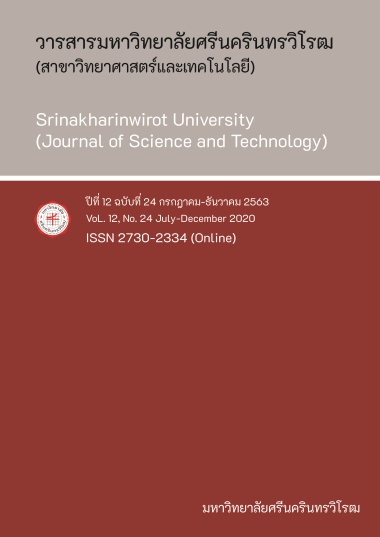ประสิทธิภาพการจัดการน้ำด้วยวิธีแบบเปียกสลับแห้งต่อการเจริญเติบโต และผลผลิตข้าว EFFICIENCY OF WATER MANAGEMENT BY ALTERNATIVE WETTING AND DRYING ON RICE GROWTH AND PRODUCTION
Keywords:
Alternative wetting and drying, Rice growth and production, Oryza sativa L. cv. RD41Abstract
Alternative wetting and drying (AWD) is an irrigation technique in which water is used to achieve intermittent flooded and non-flooded soil conditions for stimulating rice growth and production. The objective of the current study was to evaluate the potential of water use efficiency on aboveground and belowground growth of rice (Oryza sativa L. cv. RD41) under two AWD conditions. T3, water was allowed to decrease to fifteen centimeters below the soil surface and then water was added to ten centimeters above soil surface and T2, the water level was fifteen centimeters below the surface and then water was added to five centimeters above the surface of the soil. These were compared to the control where water was maintained at ten centimeters throughout the cultivation period (T1). The experiments were conducted at Prachin Buri Rice Research Center, Prachin Buri province during dry season (DS) and wet season (WS). The results showed that the amount of total water use was significantly reduced by 52% in T2 and 32% in T3 compared to the T1. The plant growth and biomass of T1 and T2 were significant different with T3 (p-value<0.05). However, root growth in WS between both AWD treatments and T1 were also significantly different (p-value<0.05). The accumulated root growth for the wet season of T1, T2 and T3 were 8,847, 11,217 and 11,896 km/ha, respectively. The results indicated that both AWD only stimulated belowground growth as root growth and expansion, while root death was similar in all treatments. In addition, the aboveground growth of plant height was correlated with root growth in soil by rapid growth until the tillering stage.
Downloads
References
[2] Office of Agricultural Economics. (2015). Compairison of greenhouse gas emission in paddy field between organic and traditional systems. Retrieved June 9, 2015, from http://www.oae.go.th
[3] Sharma, P.K. (1989). Effect of period moisture stress on water-use efficiency in wetland rice. Oryza, 26, 252-257.
[4] Yao, F., Huang, J., Cui, K., Nie, L., Xiang, J., Liu, X., Wu, W., Chen, M., Peng, S. (2012). Agronomic performance of high-yielding rice variety grown under alternate wetting and drying irrigation. Journal of Field Crops Research, 126, 16-22.
[5] Achara Chumvong. (2008). Water management in paddy field for reduction of environmental impacts on methane and water quality. Doctor of Engineering (Irrigation Engineering). Bangkok: Graduate school Kasetsart University.
[6] Redwanur, R., & Bulbul, S.H. (2014). Effect of alternate wetting and drying (AWD) irrigation for boro rice cultivation in Bangladesh. Agriculture, Forestry and Fisheries, 2, 86-92.
[7] Russell, R.S. (1977). Plant root system: their function and interaction with the soil. McGraw-Hill, London.
[8] Charoensilp, N., Buddhaboo, C., Promnart, P., Wassmann, R., & Lantin, R.S. (2000). Methane emission from deepwater rice fields in Thailand. Nutrient Cycling Agroecosystems, 58, 121-130.
[9] Chidthaisong, A., Cha-un, N., Rossopa, B., Buddaboon, C., Kunuthai, C., Sriphirom, P., Towprayoon, S., Takida, T., Padre, A.T., & Minamikawa, K. (2017). Evaluating the effects of alternate wetting and drying (AWD) on methane and nitrous oxide emission from a paddy field in Thailand. Soil Science and Plant Nutrition, 64, 1-8.
[10] Maeght, J.L., Rewald, B., & Pierret, A. (2013). How to study deep roots - and why it matters. Frontiers in Plant Science, 4, 1-14.
[11] Bumrungbut, J., Hanpattanakit, P., Buddhaboon, C., Rossopa, B., & Chidthaisong, A. (2015). Dynamics of rice (ORYZA SATIVA L.) root and its growth in a heavy clay soil under Alternate wetting and drying conditions. In ISC2015 International soil conference: Sustainable uses of soil in Harmony with food security. Phetchaburi, Thailand: Department Land Development.
[12] Li, Y.H., Dong, B., & Yu, F. (1999). Improving irrigation management of paddy fields for sustainable increases in water productivity. In 2nd Inter-Regional Conference on Environment-Water. Lausanne, Switzerland: Presses Polytechniques et Universitaires Romandes.
[13] Yao, F., Huang, J., Cui, K., Nie, L., Xiang, J., Liu, X., Wu, W., Chen, M., & Peng, S. (2012). Agronomic performance of high-yielding rice variety grown under alternatewetting and drying irrigation. Journal of Field Crops Research, 126, 16-22.
[14] Belder, P., Bouman, B.A.M., Cabangon, R., Guoan, L., Quilang, E.J.P., Yuanhua, L., Spiertz, J.H.J., & Tuoung, T.P. (2004). Effect of water-saving irrigation on rice yield and water use in typical lowland conditions in Asia. Agricultural Water Management, 65, 193-210.
[15] Chapagain, J., & Riseman, A. (2011). Achieving more with less water: alternate wet and dry irrigation (AWDI) as an alternative to the conventional water management practices in rice farming. Journal of Agricultural Science, 3, 1-13.
[16] O’Toole J.C. (1989). Breeding for drought resistance in cereals: emerging new technologies. In: Baker FWG, ed. Drought resistance in cereals. Wallingford, UK: CAB International.
[17] Ekanayake, I., Garrity, J., & Masajo, D. (1985). Inheritance of root characters and their relations to drought resistance in rice. Crop Science, 25, 927-933.
[18] Loresto, G.C., Zhang, W., Chaudry, D., & Chang, T.T. (1983). Aeroponic technique for screening the drought avoidance mechanism of rice genotypes by the root characters. Lisboa, 10, 77-82.
[19] Yang, P., Fu, H., Walker, J., Papa, C.M., Smalle, J., Ju, Y.M., & Vierstra, R.D. (2004). Purification of the Arabidopsis 26S proteasome: Biochemical and Molecular analyses revealed the presence of multiple isoforms. Journal Biology Chemestry, 279, 6401-6413.
Downloads
Published
How to Cite
Issue
Section
License
Srinakharinwirot University Journal of Sciences and Technology is licensed Under a Creative Commons Attribution-NonCommercial-NoDerivs 4.0 International (CC-BY-NC-ND 4.0) License, Unless Otherwise Stated. Please Read Journal Policies Page for More Information on Open Access, Copyright and Permissions.



